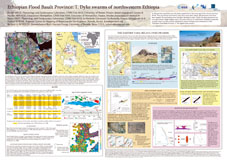
Daniel MEGE
RESEARCH













Dyke swarms of the Ethio-Sudanese lowlands
In construction... the problem is that there are two many things to say. For the moment, here is a synthesis of some results obtained on the trap-feeding dykes observed on the Abyssinian plateau, which consists of the lava pile, and the Ethio-Sudanese lowlands, where the lava pile has been eroded over 700-1000 m vertically down to its base (locally to the basement).
See the Publications page for more details (especially the two papers by Mège and Korme, 2004, and Mège, 2009). The poster presented at IDC-6 gives a visual summary.
It includes all the reliable dyke ages obtained to date by Nicolas Arnaud at Gésciences Montpellier. We will publish these data in a peer-reviewed paper as soon as possible.
-
In Abyssinia, many dykes are observed despite the lava cover, but can usually not be followed over long distances. Most dykes are intensely altered by hydrothermalism. Nevertheless, in central Abyssinian, reliable ages of 30.97±0.41 and 30.7±0.36 Ma have been obtained for a dyke from a swarm in the Lalibela region, and another one north of the Angareb ring complex. Along the Afar margin, slightly younger Oligocene ages have also been found, as well as lower and upper Miocene ages, respectively prior to and during the birth of the Afar depression. Remarkably, no dyke has been reported to cross the Blue Nile river valley, which incises the Abyssinian lava pile over a distance of 400 km and a depth of 1000 m, emphasizing uneven feeder dyke distribution in the volcanic province.
-
The Ethio-Sudanese plain West of Lake Tana displays thousands of dykes. The largest swarm, called the Serpent-God Dyke Swarm, trends NE-SW and includes thick (5-20 m) silicic dykes and thinner (< 5 m) mafic dykes outcropping over distances up to 30 km that could be dated 31.3±0.36 to 29.3±0.98 Ma. The Serpent-God Dyke Swarm dyke swarm seems to follow the Precambrian Tulu Dimtu shear zone, suggesting that the lithospheric fabric and basal topography may have played a role in trapping the melts. Analysis of dyke population length distribution suggests that the mafic dykes less than 10 km long in the present topography may not have erupted. The distribution law for mafic and silicic dyke populations does not have the same coefficient and exponent, perhaps due to a different mode of emplacement. The silicic dykes could originate from crustal melting whereas the mafic dykes originate from the mantle, a duality also noted in the geochemistry of the erupted lavas. Dyke thickness is related to length following a square-root power law, demonstrating that elastic fracture mechanics can account for the geometrical aspects of their emplacement, and that the emplacement depth was shallow enough for fracture toughness-based analysis to make sense. Field evidence, anisotropy of magnetic susceptibility measurements, and high fracture toughness, indicate a syn-emplacement component of shearing, perhaps in response to the slight orientation difference between the orientation of the principal stress field during emplacement and the orientation of the Precambrian crustal fabric. The Ethio-Sudanese plain is intruded by many other mafic dykes displaying a complex geometry, denoting local-scales variations in stress field orientation, and perhaps proximity of buried magma chambers. Those dykes are younger, probably upper Oligocene or Miocene.
-
Finally, an undated N-S-trending swarm of at least a dozen of long (tens of km) and thick (up to 20 m) dykes, mainly mafic, remains poorly characterized due to difficult field access. Existence of many other dykes North of a Gonder-Metema line is evident but for the same reason they remain unexplored.
This work has been carried out with Nicolas Arnaud (Univ. Montpellier II), Hervé Diot (Univ. La Rochelle), Tesfaye Korme (RCMRD), and Tewodros Rango (Univ. Ferrara).

